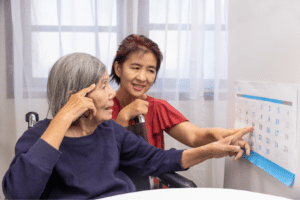A new and unfamiliar caregiver situation has the potential to be uncomfortable on all sides: for the caregiver, for your aging loved one, and for you. But what if there was a really clear picture heading into it about everything the aging adult needs, as well as the things they love to spend their time doing? When a new caregiver steps in to relieve a regular caregiver, a respite care plan allows that initial adjustment phase to be shortened, so the new caregiver and the aging adult are able to start getting to know each other in enjoyable ways immediately.
What Is a Respite Care Plan?
A respite care plan is a collection of documents and instructions that help to prepare a new caregiver to fill in for a primary caregiver. A respite caregiver might be a family member, a neighbor, or a professional—but in all cases, a care plan can help them be well informed and give the best quality of care to your aging loved one.
This paperwork may be stored on a computer for easy updates, but it helps to have a printed, up-to-date packet that a caregiver can quickly access and find what they need.
Why Is a Respite Care Plan Important?
- It’s really important that, as a primary caregiver, you feel free and able to take breaks and take care of yourself. (Take this caregiver stress test to see if you need some rest and rejuvenation.)
- The overall experience of secondary caregiving will be a safer, more comfortable one because the new caregiver has everything on hand to take care of regular and emergency plans.
- With the logistical concerns tied up in this respite care plan and out of the way, your aging loved one will enjoy more focused attention and feel more confident in their care.
While it can take some time gathering all the necessary information and preparing your plan for respite care, it’s worth the effort. And this packet will likely be very helpful in other situations too—when you need to quickly reference these important details.
What Should A Respite Care Plan Look Like?
We’ve prepared a list of many of the helpful items that would be relevant in a caregiver scenario. But keep an eye out for details that aren’t on the list, and add them as you go.
Prepare your respite care plan with the following types of information:
- Medical information
- Personal routines
- Interests and activity ideas
- Emergency procedures
Your Respite Care Plan Template
Medical information
- List medications and dosage instructions.
- Keep the medications in their original bottles and in an easily accessible location.
- Draft a medical summary with background information the caregiver should know.
- Prepare a more comprehensive medical record in case the caregiver needs to refer to or share it in an emergency situation.
- List names and contact information for doctors.
- List all of your loved one’s allergies: foods, medicines, and materials.
- Be sure that any sensory aids (glasses, hearing aids, extra batteries) are accessible—perhaps stored with the medications.
Personal Routines
- Write down your loved one’s regular sleeping, waking, and meal times—and any other timely routines a caregiver should know about.
- Indicate whether there are times of the day when your aging loved one may have more or less energy, as well as any mood changes a caregiver should watch for.
- List some food suggestions the older adult enjoys.
- List all of the activities they need help with, such as standing, walking, exercises, reading, personal care, and hygiene.
Interests and Activity Ideas
- Brainstorm a list of things your aging loved one enjoys.
- Some ideas include writing letters and sending cards, walking or another exercise, music, dancing, mental exercises, social day programs, calling or video chatting with family and friends, telling stories, and playing games.
Emergency Procedures
- Create a list of emergency contacts with name, relation, phone number, backup phone number, and address for all people on the list.
- Give the information for the nearest hospitals and emergency rooms, including address, phone number, and open hours, if applicable.
- Provide a copy of your evacuation plan in case of disasters—especially relating to the aging adult’s needs.
How to Organize and Update Your Caregiver Paperwork
For these preparation documents to be really helpful, you must keep them organized and current. We suggest including a cover page that acts as a table of contents, helping a caregiver to identify the page number or section that they need to turn to for a certain detail. Bringing this paperwork with you to your loved one’s doctors appointments can be a good reminder to update any recommended changes to care on the spot. You could also mark dates on your calendar (once a month might be sufficient) to review the documents and catch any changes you forgot to implement.
Get Your Aging Loved One Involved
Encourage your loved one to help you collect these records and especially to fill out the more personal interest-based details. Ask them what are the activities they might like to introduce to a new friend. Invite them to express any concerns they have about working with an unfamiliar caregiver and brainstorm ways to make those concerns more manageable. It’s important that they feel involved in the whole process. When they are, respite care experiences have the best chance of progressing positively.
A Respite Care Plan Is a Comprehensive Strategy for Compassionate Caregiving
This process of careful review can be beneficial whether you’re planning for respite care or not. It helps you to get a fresh perspective on the routines that can seem to happen automatically after a while. Thinking this way might just spark new ideas for activities, better processes, and greater personal connection. And you may just feel less stress around the details—a gift for you and your aging loved one.
For more innovative ideas for caregivers, check out Institute on Aging’s blog. We’re also here to help you assess your in-home care plan and to invite your loved one to our Social Day Program, a lively alternative to respite care. Give us a call to find out more.







